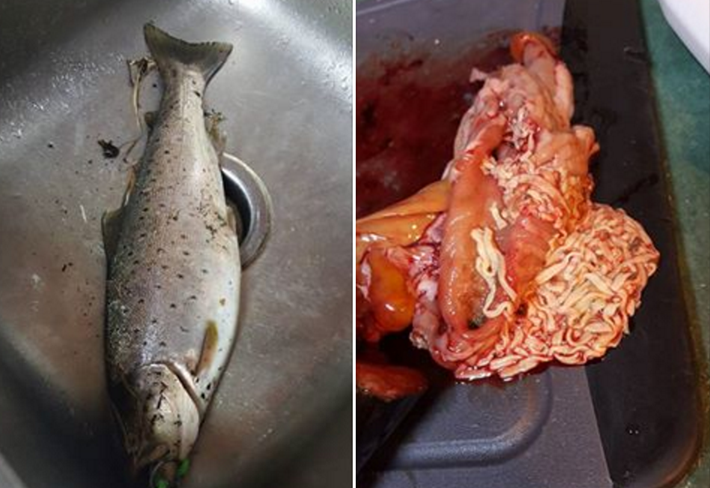Last night I was reading an interesting new post in the Cape Breton Fishing Fanatics Facebook group. Member, John Michael Johnson, posted a photo of a brown trout he caught recently (shown above). To his surprise when cleaning it, it was riddled with parasites. So he sought out advice from fellow fishing fanatics in the group.
Though there was wide consensus that the parasites were off putting, most fishermen who commented suggested that the fish could still be eaten and there was no risk for human consumption. Several reminded that if we were to start thinking about the parasites present in many of our other food sources, the discovery wouldn't seem so out of the ordinary.
A few years ago, I made a similar discovery after catching a trout in a lake in Catalone. In a few of the 10 to 12 inch trout I caught, there were flat shaped, white worms within the body cavity. There were also some unusual black dots on the exterior skin of the fish.
I reached out to the province and received a response from David Cone, a biologist at St. Mary's University (not a major league pitcher).
Here was the response:
"There are two possibilities here, with both involving cestode flatworms, common parasites of trout.
If they were free in the body cavity, often on top of the liver, then they are the larval stage of a cestode parasite (Diphyllobothrium) that uses fish as a second intermediate host, the first being a free-living copepod, the third typically being a fish eating bird. So fish get infected by eating the copepod; the bird gets infected as the definitive host by eating an infected fish.
If they were actually in the intestine which was cut during clearing then the parasites are adult cestodes that live and reproduce in the gut of fish (the definitive host). Eggs leave with fish feces. Eggs hatch and infect a copepod which passes a larval phase of the cestode on to fish.
The black spot on the skin which you refer to is a larval stage (metacercaria) of a digene parasite which lives as an adult in the intestine of a fish eating bird; they lay eggs which pass out in fish feces, hatch and infect a snail. Inside the snail the parasite reproduces asexually and turns into large numbers of cercaria, which are free swimming and invade the skin of trout, to wait until that trout gets eaten by a fish eating bird, where it matures."
And also:
"The parasite poses no risk to humans.
And its presence in a system has nothing to do with the 'health' of either the fish or the environment. In fact some would argue that the presence of the parasite diversifies the system. Since gulls, and possible other fish eating birds and mammals, are the definitive host of the parasite it means there is likely a colony nearby."
So there you have it. The parasites pose no risk to humans and they can be eaten. Whether or not you will eat them if you're tasked with cleaning them and make a similar discovery is another story. In my case, they went to the freezer instead of the bag of flour and the fry pan. For others, it's just a part of nature and doesn't stop them from enjoying their catch.
Now let's think about anything else but parasites. Here's local fishermen Skyler Jeddore landing a nice pan fry sized brown trout during a recent morning fishing outing from the shore. He creates some interesting videos using his head mounted GoPro camera that is voice activated when he's ready to capture the action. Fish on!






0
Log In or Sign Up to add a comment.- 1
arrow-eseek-eNo items to displayFacebook Comments